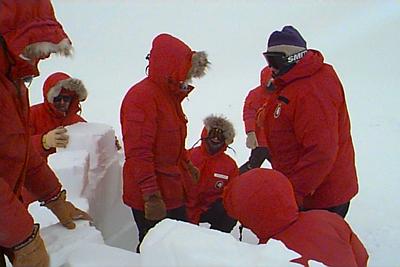
|
|
12 October, 1996
The four group members who are new to Antarctica, Chris, Jenni, Gamini, and
I just returned from snow training. There are many unique hazards to the
people who work in this environment but the most common is the cold. There
is nothing like a few days on a glacier, sleeping in a small tent, to make
you realize how quickly the cold can incapacitate you.
We spent most of the first day out preparing a camp, cooking meals, and
trying to keep warm. There were sixteen in our group and we had two
three-person tents and two two-person tents. Our first priority was to
construct enough shelters for everyone to get through the night. The
temperature with wind chill was -45o F so it was critical that we get
protection from the wind. By cutting the snow into blocks and stacking them
on top of each other we were able to construct a snow wall for immediate
protection.
When the wall was completed we turned our attention to building a shelter
to sleep in. We put all our sleeping bags in a pile, covered them with a
tarp, and shoveled about three feet of snow on top of the pile. After
packing the snow on top of our gear, we dug an opening at the bottom of the
snow-mound so we could pull out the sleeping bags. If you can envision this,
you'll realize that when the sleeping bags were removed, we had an igloo
without having to cut blocks of snow. The activity of constructing the
shelters kept me warm to the point of sweating. Fortunately my extreme cold
weather clothing was designed to carry the perspiration away from my body.
This was critical since wet clothing isn't very effective in maintaining
body heat. The problem we all experienced was the dehydration that resulted
from the sweating and heavy breathing. Since the relative humidity was so
low, each breath carried water away from our bodies. Although we had water
bottles, drinking from them would have lowered our core body temperatures.
We knew that we had to heat the water and drink lots of it.
The constant drinking gave rise to a second and more serious problem.
Gamini had to unload some of this water and that required unzipping about
five zippers. To accomplish this he had to take off his glove. By the time
he was able to get it back on his hand, he had frost bitten fingers. Since
all field units are in radio contact with McMurdo Operations Center, we were
able to notify a search and rescue team of our problem. Within a half-hour a
spryte was at the camp to take him to a heated site. Gamini later regained
the use of his fingers and we learned a valuable lesson. In Antarctica you
think through every activity before you begin and you never underestimate
the affect of the cold. This will be important to us because in the next few
weeks we'll be going to field sites by helicopter and won't have the luxury
of a rescue vehicle in bad weather conditions.
This is a new type of science for me, it requires months of preplanning and
preparation and a support team that includes construction workers, pilots,
mechanics, divers, communication specialists, medical personal plus a host
of others. A private contractor, the Antarctic Support Association, provides
the support team. Of the sixteen people in our group, eleven were ASA
employees. Most had academic degrees in science and realized their jobs gave
them the chance to be in one of the last frontiers on the planet.


Contact the TEA in the field at
.
If you cannot connect through your browser, copy the
TEA's e-mail address in the "To:" line of
your favorite e-mail package.
|
